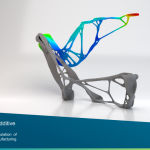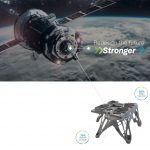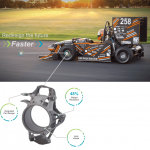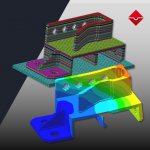Simufact Additive
Simufact Additive is a scalable software solution for the simulation of metal-based additive manufacturing processes which focuses on powder bed melting (L-PDF) and metal binder jetting (MBJ) processes. Simufact Additive is a software solution designed to predict and compensate for distortion, residual stress and temperature distribution throughout the printing, heat treatment, cutting, hot isostatic pressing (HIP) as well as machining processes virtually before the part is manufactured by the 3D metal printer in reality.
Your benefits with Simufact Additive
Print your 3D AM parts first-time-right with Simufact Additive:
- Sustainability: Save material and money by replacing expensive physical tryouts with virtual tests
- User-friendly, intuitive and process orientated GUI
- Deepen your knowledge of the metal AM process
- Compensate distortion automatically to print the part as-designed
- Optimise the build-up orientation and the support structures
- Indicate criteria-based part failures, i.e. shrink lines
- Estimate your costs for single parts and the entire printing job
The most important functions at a glance
- Compensate distortion by preforming the component – automatically
- Calculate and minimize residual stresses
- Identification of cold and hot spots by thermal / thermo-mechanical simulation
- Identify manufacturing problems, such as recoater contact, part defects, and coating offsets
- Calculate the influence of several components in the build space
- Determine the best building orientation – supported by an orientation assistant
- Generating and optimizing support structures – based on Materialise technology
- HIP Process: Investigating conditions of highly increased temperatures and pressures
- Be able to control the condition after heat treatment and removal of the base plate and support structure

Achieve your business goals with Simufact Additive
Replace time-consuming tests with simulation!
Apply process simulation with Simufact Additive to save time and money:
- Shorten your learning process clearly
- Try out more variants before starting production
- Shorten time to market
- Increase machine and manpower availability and productivity
- Reduce material and energy costs
Simufact Additive covers the core of the additive manufacturing process, including:
- the simulation of additive / generative manufacturing processes in the build space
- the simulation of post-processing processes:
- Heat treatment / stress relief process
- Removal from the base plate, removal of the support structure
- HIP process (hot isostatic pressing): prediction of distortion, residual stress and material compaction
MSC Software also provides other solutions:
- Poylmer and Composite AM (Digimat AM)
- Material & Lifecycle Management (MaterialCenter)
WE WORK WITH YOU
We pride ourselves on empowering each client to overcome the challenges of their most demanding projects.
Enteknograte offers a Virtual Engineering approach with FEA tools such as MSC Softwrae(Simufact, Digimat, Nastran, MSC APEX, Actran Acoustic solver), ABAQUS, Ansys, and LS-Dyna, encompassing the accurate prediction of in-service loads, the performance evaluation, and the integrity assessment including the influence of manufacturing the components.

Directed Energy Deposition (DED), Direct Metal Deposition (DMD) & Laser Metal Deposition (LMD): Finite Element Simulation-Based Design
Finite Element simulation allows the prediction of the final distortions in Directed Energy Deposition (DED), Direct Metal Deposition (DMD) & Laser Metal Deposition (LMD) and their compensation to obtain an optimized DED component. With using advanced FEA software and HPC hardware, here at Enteknogarte, we solve the Direct Energy Deposition problems in detail to capture and analyzing the coupled thermal-mechanical response of the process, Investigating phase transformations during cooling process, Predicting distortions and residual stress build up during the process and Studying the influence of speed and power of heating sources on the process.
Read more... Finite Element Simulation of Powder Bed Fusion Processes
Powder Bed Fusion (PBF) technique enables the manufacturing of a vast array of geometrically complex products using a heat source, mainly laser or electron beams, to fuse powder particles layer-by-layer, therefore forming a solid part. Manufacturers can benefit from substantial freedom of design considering that PBF presents several viable technologies and materials.
Read more... Metal Binder Jetting: Finite Element Simulation-Based Design
Metal Binder Jetting (MBJ) is an emerging additive manufacturing technology that has several key advantages over common Powder Bed Fusion processes; high volumes of parts can be printed with minimal spacing; no support structures are needed, and larger lot sizes are possible. It has the potential to replace low-volume, high-cost metal injection moulding for everything from automotive and aircraft parts to medical applications. Because high resolution is possible, it could also reduce the cost and lead times for production of complex and lightweight metallic parts such as gears or turbine wheels.
Read more... Additive Manufacturing of Plastics, Reinforced Polymers & Composites
Additive manufacturing of plastics and composites is evolving from rapid prototyping to industrial production. We use advanced additive manufacturing simulation platforms such as MSC Digimat, Ansys and Abaqus for simulation solution for manufacturing process of Fused Filament Fabrication (FFF), Fused Deposition Modeling (FDM) and Selective Laser Sintering (SLS) of reinforced materials. For printer manufacturers and end-users, the part fidelity is the top challenge to overcome. Simulation-based design allows our engineers to predict warpage and residual stresses of a polymer part as a function of the manufacturing process parameters. We can further optimize the process and minimize the part deformation right at their fingertips.
Read more... Generative Design for Additive Manufacturing & Lattice Structures: Topology, Shape and Bead Optimization
Generative Design is an innovation that significantly alters this way of thinking. It leverages topology optimization, artificial intelligence, and advanced simulation which automatically creates multiple viable design alternatives by specifying simple design criteria.
For additive manufacturing, Optimized structure is the most important thing, and there is big effort to include all aspect of real-world physics to simulation for accurately simulate the process. In the early stages of design, FEA based Simulation in combination with artificial intelligence for topology optimization, shape optimization, bead optimization and lattice structures design, can reveal various design options to reduce weight and materials, while also maintaining and improving the rigidity and durability of the product.
Read more... Integrated Artificial Intelligence (AI) & Machine Learning - Deep Learning with CFD & FEA Simulation
Machine learning is a method of data analysis that automates analytical model building. It is a branch of Artificial Intelligence based on the idea that systems can learn from data, identify patterns and make decisions with minimal human intervention. With Artificial Intelligence (AI) applications in CAE, that is Mechanical Engineering and FEA and CFD Simulations as design tools, our CAE engineers evaluate the possible changes (and limits) coming from Machine learning, whether Deep Learning (DL), or Support vector machine (SVM) or even Genetic algorithms to specify definitive influence in some optimization problems and the solution of complex systems.
Read more... Additive Manufacturing and 3D Printing
FEA Based Design and Optimization with Simufact, Abaqus, ANSYS and MSC Apex for powder bed fusion (PBF), directed energy deposition (DED) and binder jetting processes
With additive manufacturing, the design is not constrained by traditional manufacturing requirements and specific number of design parameters. Nonparametric optimization with new technologies such as Artificial Intelligence in coupled with Finite Element method, can be used to produce functional designs with the least amount of material. Additive manufacturing simulations are key in assessing a finished part’s quality. Here at Eneteknograte, dependent of the problem detail, we use advanced tools such as MSC Apex Generative Design, Simufact Additive, Digimat, Abaqus and Ansys.
Read more... Heat Transfer and Thermal Analysis: Fluid-Structure Interaction with Coupled CFD and Finite Element Based Simulation
We analyze system-level thermal management of vehicle component, including underhood, underbody and brake systems, and design for heat shields, electronics cooling, HVAC, hybrid systems and human thermal comfort. Our Finite Element (LS-Dyna, Ansys, Abaqus) and CFD simulation (Siemens Start-ccm+, Ansys Fluent , Ansys CFX and OpenFoam) for heat transfer analysis, thermal management, and virtual test process can save time and money in the design and development process, while also improving the thermal comfort and overall quality of the final product.
Read more... Vibration Fatigue Finite Element Simulation: Time & Frequency Domain
Structural vibration can be a source for many product related problems; it can cause fatigue and durability problems as well as adverse reactions to the user or bystanders in the form of undesirable vibrations that can be felt or heard. As well, undesired structural vibrations can prevent products from operating as required and potentially becoming a safety concern. The Vibration Fatigue simulation predict fatigue in the frequency domain and it is more realistic and efficient than time-domain analysis for many applications with random loading such as wind and wave loads.
Read more... Finite Element Simulation of Heat Treatment
In principle, there are two kinds of heat treatment processes: processes resulting in a thorough change of the microstructure and processes that result in merely changing regions close to the surface of the component. Examples of the former would be thermal processes, such as annealing and hardening. Examples of the latter, thermochemical processes, would be diffusion and coating processes, such as carburization, case hardening, nitrating, boriding.
Read more... Finite Element Analysis of Durability and Fatigue Life
Vibration Fatigue, Creep, Welded Structures Fatigue, Elastomer and Composite Fatigue with Ansys Ncode, Simulia FE-Safe, MSC CAEFatigue, FEMFAT
Durability often dominates development agendas, and empirical evaluation is by its nature time-consuming and costly. Simulation provides a strategic approach to managing risk and cost by enabling design concepts or design changes to be studied before investment in physical evaluation. The industry-leading fatigue Simulation technology such as Simulia FE-SAFE, Ansys Ncode Design Life and FEMFAT used to calculate fatigue life of multiaxial, welds, short-fibre composite, vibration, crack growth, thermo-mechanical fatigue.
Read more... Finite Element Simulation of Laser Beam / Electron Beam Welding
Laser Beam welding is a thermal joining process, in which a component is heated and welded by a laser beam. It is a high-end process for application cases requiring the highest degree of precision. A huge advantage of laser beam welding lies in the relatively narrow heat affected zone. Electron Beam welding is a thermal joining process, in which a component is heated and welded by electron beam.
Read more... Finite Element Welding Simulation: RSW, FSW, Arc, Electron and Laser Beam Welding
Enteknograte engineers simulate the Welding with innovative CAE and virtual prototyping available in the non-linear structural codes such as LS-DYNA, Ansys, Comsol, Simufact Welding, ESI SysWeld and ABAQUS. The Finite element analysis of welding include Arc Welding, laser Beam Welding, RSW, FSW and transfer the results of welding simulation for next simulation like NVH, Crash test, Tension, Compression and shear test and fatigue simulation. We can develop special purpose user subroutine (UMAT) based on clients need to empower simulation environment to overcome any complicated problem in heat load condition, phase change and user defined material constitutive equation.
Read more... Metal Forming Simulation: FEA Based Design and Optimization
Using advanced Metal Forming Simulation methodology and FEA tools such as Ansys, Simufact Forming, Autoform, FTI Forming, Ls-dyna and Abaqus for any bulk material forming deformation, combining with experience and development have made Enteknograte the most reliable consultant partner for large material deformation simulation: Closed die forging
Open die forging processes such as cogging, saddling, and other GFM, processes
Rolling for long products,
Extrusion,
Ring Rolling,
Cross Wedge Rolling and Reducer Rolling for pre-forming
Cold forming,
Sheet metal forming.
Read more... Casting: Finite Element and CFD Simulation Based Design
Using Sophisticated FEA and CFD technologies, Enteknograte Engineers can predict deformations and residual stresses and can also address more specific processes like investment casting, semi-solid modeling, core blowing, centrifugal casting, Gravity Casting (Sand / Permanent Mold / Tilt Pouring), Low Pressure Die Casting (LPDC), High Pressure Die Casting (HPDC), Centrifugal Casting and the continuous casting process. The metal casting simulation using FEA and CFD based technologies, enable us to address residual stresses, part distortion, microstructure, mechanical properties and defect detection.
Read more... FEA Based Composite Material Design and Optimization: MSC Marc, Abaqus, Ansys, Digimat and LS-DYNA
Finite Element Method is an efficient tool for development and simulation of Composite material models of Polymer Matrix Composites, Metal Matrix Composites, Ceramic Matrix Composites, Nanocomposite, Rubber and Elastomer Composites, woven Composite, honeycomb cores, reinforced concrete, soil, bones ,Discontinuous Fiber, UD Composit and various other heterogeneous materials. Enteknograte Engineers are very skilled in design of composite structural parts for crash and impact analysis using advanced finite element tools:
Deformation and damage analysis,
Material failure predictions,
Drop and crushing testing,
High-speed and hypervelocity impacts,
Highly nonlinear transient dynamic forces,
Explosive loading and forming.
Read more... Acoustics and Vibration: FEA and CFD for AeroAcoustics, VibroAcoustics and NVH Analysis
Noise and vibration analysis is becoming increasingly important in virtually every industry. The need to reduce noise and vibration can arise because of government legislation, new lightweight constructions, use of lower cost materials, fatigue failure or increased competitive pressure. With deep knowledge in FEA, CFD and Acoustic simulation, advanced Acoustic solvers and numerical methods used by Enteknograte engineers to solve acoustics, vibro-acoustics, and aero-acoustics problems in automotive manufacturers and suppliers, aerospace companies, shipbuilding industries and consumer product manufacturers.
Read more... In Silico Medical & Biomedical Device Testing: Finite Element & CFD Simulation and Design, Considering FDA & ASME V&V 40
Enteknograte Biomedical Engineers use FEA and CFD for simulating: Orthopedic products, Medical fasteners, Ocular modeling, Soft tissue simulation, Packaging, Electronic systems, Virtual biomechanics, Knee replacement, Human modeling, Soft tissue and joint modeling, Hospital equipment, Laser bonding, Ablation catheters, Dental implants, Mechanical connectors, Prosthetics, Pacemakers, Vascular implants, Defibrillators, Heart valve replacements.
Read more... Simulation of Plasma Based Devices: Microwave Plasma and RF Plasma Analysis with Coupling Particle in Cell (PIC), MHD, CFD and FEA Solvers
Charged particles and their non-linear discharge characteristics have been especially difficult to model and simulate accurately. We provide consulting services for the modeling and simulation of plasma and other flow systems. Our consulting services utilize our specialized domain expertise in plasma, reactive flows and surface chemistry mechanism development and integration with multi-dimensional flow and plasma systems.
Read more... Electromagnetic Multiphysics FEA & CFD Based Simulation
Enteknograte Finite Element Electromagnetic Field simulation solution which uses the highly accurate finite element solvers and methods such as Ansys Maxwell, Simulia Opera, Simulia CST, JMAG, Cedrat FLUX, Siemens MAGNET and COMSOL to solve static, frequency-domain, and time-varying electromagnetic and electric fields includes a wide range of solution types for a complete design flow for your electromagnetic and electromechanical devices in different industries.
Read more... Hydrodynamics: Coupled CFD and FEA simulation for FSI Analysis
Marine and offshore structures, Transient Resistance, Propulsion, Sea-Keeping and Maneuvering Simulation, Cavitation, Acoustics, Vibration and Fatigue
Hydrodynamics is a common application of CFD and a main core of Enteknograte expertise for ship, boat, yacht, marine and offshore structures simulation based design. Coupling Hydrodynamic CFD Simulation in Ansys Fluent, Siemens Star-ccm+ and MSC Cradle with structural finite element solver such as Abaqus and Ansys, enable us to Simulate most complicated industrial problem such as Cavitation, Vibration and Fatigue induced by hydrodynamics fluctuation, Transient Resistance, Propulsion, Sea-Keeping and Maneuvering Simulation, considering two way FSI (Fluid Structure Interaction) coupling technology.
Read more... Aerodynamics Simulation: Coupling CFD with MBD, FEA and 1D-System Simulation
Aerodynamics studies can cover the full speed range of low speed, transonic, supersonic and hypersonic flows as well as turbulence and flow control. System properties such as mass flow rates and pressure drops and fluid dynamic forces such as lift, drag and pitching moment can be readily calculated in addition to the wake effects. This data can be used directly for design purposes or as in input to a detailed stress analysis. Aerodynamics CFD simulation with sophisticated tools such as MSC Cradle, Ansys Fluent and Siemens Star-ccm+ allows the steady-state and transient aerodynamics of heating ventilation & air conditioning (HVAC) systems, vehicles, aircraft, structures, wings and rotors to be computed with extremely high levels of accuracy.
Read more... Previous
Next













